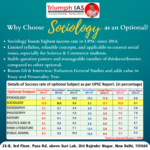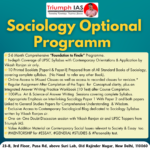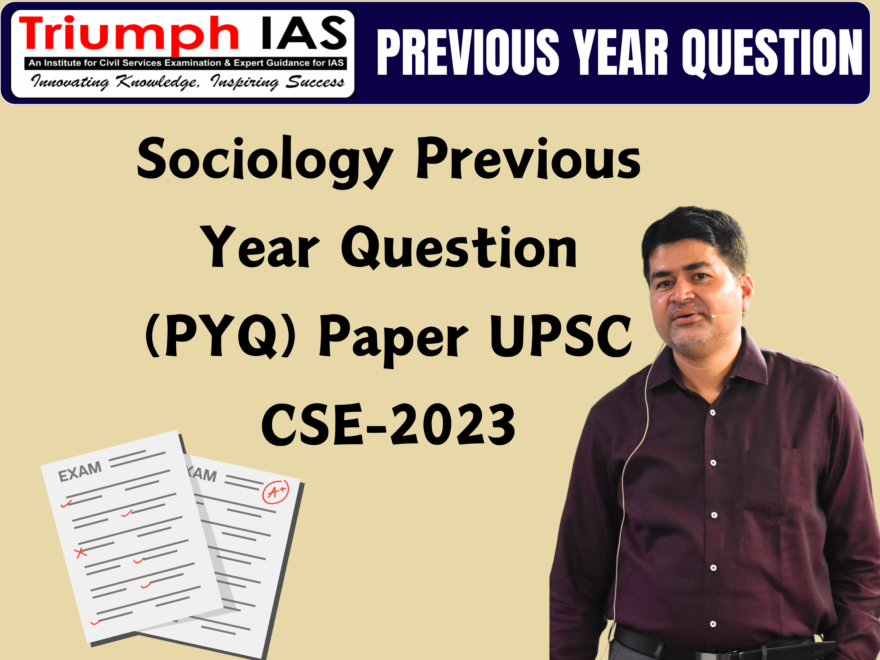Sociology Previous Year Question Paper UPSC CSE-2023
The importance of previous year question papers in the preparation for the UPSC Main Exam is multifaceted. Here’s a summary of the key points.
In essence, previous year question papers are an indispensable part of UPSC exam preparation, acting as a bridge between your knowledge and the actual exam requirements. They not only enhance your understanding of the exam structure but also sharpen your answering skills, making them a vital tool in your study arsenal. |
SOCIOLOGY PAPER 1 2023
SECTION A
Question no 1. Answer the following questions in about 150 words each: (10-5-50)
- a) What is the distinctiveness of the feminist method of social research? Comment. UNIT 2 MAJOR THEORETICAL STRANDS
- b) Discuss the relationship between sociology and political science. UNIT 1 CAMPIRISON WITH OTHER SOCIAL SCIENCES
- c) How does the dramaturgical perspective enable our understanding of everyday life? UNIT 2 MAJOR THEORETICAL STRANDS
- d) Is reference group theory a universally applicable model? Elucidate. UNIT 4 SOCIOLOGOCAL THINKER R. K. MERTON
- e) Do you think that the boundary line between ethnicity and race is blurred? Justify your answer. UNIT 5 STARTIFICATION AND MOBILITY: ETHNICITY AND RACE
(Watch Sociology Trend Analysis for 2024 of Previous Year Questions)
Question no 2.
- a) What, according to Robert Michels, is the iron law of oligarchy? Do lions and foxes in Vilfredo Pareto’s theory, essentially differ from each other? Substantiate. (20) UNIT 7 POLITICS AND SOCIETY
- b) What is historical materialism? Examine its relevance in understanding contemporary societies. (20) UNIT 4 SOCIOLOGOCAL THINKER KARL MARX
- c) What are variables? How do they facilitate research? (10) UNIT 3 RESAERCH METHODS AND ANALYSIS: VARIABLES
Question no 3.
- a) What are the characteristics of scientific method? Do you think that scientific method in conducting sociological research is fool proof? Elaborate. (20) UNIT2 SOCIOLOGY AS SCIENCE
- b) How do you assess the changing patterns in kinship relations in societies today? (20) ) UNIT 9 SYSTEM OF KINSHIP
- c) Is Weber’s idea of bureaucracy a product of the historical experiences of Europe? Comment. (10) UNIT 4 SOCIOLOGICAL THINKERS MAX WEBER
Question no 4.
- a) Do you think that common sense is the starting point of social research? What are its advantages and limitations? Explain. 20) UNIT2 SOCIOLOGY AS SCIENCE: SOCIOLOGY AND COMMON SENSE
- b) How is poverty a form of social exclusion? Illustrate in this connection the different dimensions of poverty and social exclusion. 20 UNIT 5 STARTIFICATION AND MOBILITY: EXCLUSION AND POVERTY
- c) Highlight the differences and similarities between totemism and animism. 10 UNIT 8 RELEGION AND SOCIETY: TYPES OF RELEGIOUS Practices
SECTION B
- Answer the following questions in about 150 words each : 10×5-50
- a) Examine the relevance of corporate social responsibility in a world marked by increasing environmental crises. UNIT 10 SOCIAL CAHNGE IN MODERN SOCIETY
- b) How is civil society useful in deepening the roots of democracy? UNIT 7 POLITICS AND SOCIETY: CIVIL SOCIETY
- c) What functions does religion perform in a pluralistic society? UNIT 8 RELEGION AND SOCIETY
- d) Analyze critically David Morgan’s views on family practices. UNIT 9 SYSTEM OF KINSHIP
- e) Does women’s education help to eradicate patriarchal discriminations? Reflect with illustrations. UNIT 10 SOCIAL CAHNGE IN MODERN SOCIETY: EDUATION AND SOCIAL CHANGE
Question no 6.
- a) What are the different dimensions of qualitative method? Do you think that qualitative method helps to gain a deeper sociological insight? Give reasons for your answer. 20 UNIT 3 Research methods and analysis
- b) Explain Max Weber’s theory of social stratification. How does Weber’s idea of class differ from that of Marx? 20 UNIT 5 STARTIFICATION AND MOBILITY:
- c) What are the ethical issues that a researcher faces in making use of participant observation as a method of collecting data? Explain. 10 Unit 3 research methods and analysis
Question no 7.
- a) Explain how economic globalization has brought changes in the patterns of employment in the 21st century. 20 unit 6 work and economic life
- b) Do you think that the social media has brought significant changes in the forms of protest? Argue your case. 20 Unit 7 politics and society: protest
- c) Assess critically A. G. Frank’s ‘theory of development of underdevelopment’. UNIT 10 SOCIAL CAHNGE IN MODERN SOCIETY: DEVELOPMENT AND DEPENDENCY
Question no 8.
- a) What is Taylorism? Analyze its merits and demerits. 20 UNIT 6 WORK AND ECONOMIC LIFE
- b) What are new religious movements? Elaborate emphasizing their forms and orientations. 20 UNIT 8 RELEGION AND SOCIETY: RELEGIOUS REVIVALISM
- c) Examine the role of science and technology in addressing age-old taboos and superstitions. 10 UNIT 10 social change in modern society-science and technology and social change
SOCIOLOGY PAPER 2 2023
SECTION A
Question no 1: Write short answers, with a sociological perspective, on the following questions in about 150 words each: 10×5=50
- Highlight the significant features of A. R. Desai’s ‘Dialectical Perspective’ to study Indian Society. PRESPECTIVES ON INDIAN SOCIETY : A R DESAI
- “The decade of 1950s was the golden period of village studies in Indian Sociology. Explain the statement. Rural and Agrarian Social Structure: The idea of Indian village and village studies
- Analyse the differences between the attributional and interactional approach in studying the caste system. Caste System
- Are Tradition and Modernity antithetical to each other? Comment. Modernization of Indian tradition.
- Discuss the main features of Land Reforms in post-independence India. Rural and Agrarian Social Structure: land reforms.
Question no 2.
- Do you agree with the view of Andre Beteille that India’s villages are representative of Indian society’s basic civilizational values? Present a sociological overview. 20 Rural and Agrarian Social Structure: The idea of Indian village and village studies
- Elaborate the salient features and the role of middle class in India’s democracy and development. 20 Social Classes in India: MIDDLE CLASS
- Analyse the role of market and modern forces in understanding the changing trends in marriage systems in India. 10 Systems of Kinship in India: Family and marriage in India.
Question no 3.
- Contextualize Louis Dumont’s concept of binary opposition’ with reference to caste system in India. 20 Caste System
- Define the concepts of ‘Descent’ and ‘Alliance’. Differentiate between North Indian and South Indian Kinship systems with examples. 20 Systems of Kinship in India:
- Critically examine the concept of Sanskritization with suitable illustrations. 10 PRESPECTIVES ON INDIAN SOCIETY : M. N. SRINIVAS
Question no 4.
- Analyse the perspectives of Isolation, Assimilation and Integration in understanding the trajectories of Indian Tribal Development. 20 Tribal communities in India: Issues of integration and autonomy
- Explain the implications and the impact of globalization in situating the changing agrarian class structure in India. 20 Social Classes in India :Agrarian class structure
- Critique the victory narratives of Green Revolution in the context of Indian society. 10 Rural and Agrarian transformation in India : Green revolution and social change.
SECTION B
Question no 5. Write short answers, with a sociological perspective, on the following questions in about 150 words each: 10×5=50
- Citing some case studies, expand the concept of ‘Development-induced Displacement’. 10 Challenges of Social Transformation: Crisis of development: displacement
- Examine the concept of ‘Cultural Pluralism’ in the context of India’s Unity in Diversity. 10 Politics and Society
- Highlight the salient features of the New Education Policy (NEP) 2020. 10 Visions of Social Change in India: Education and social change.
- Analyse the sociological interconnections between Social Media and Mass Mobilization in India. 10 Politics and Society:
- Discuss the nature of regional variations in sex ratio in India, stating reasons thereof. 10 Population Dynamics: Emerging issues: sex ratios
Question no 6.
- How do you account for the increasing significance of religion in public and personal spheres in the context of secularization thesis in India? Explain. 20 Politics and Society: SECULARISATION
- In the face of rising global climatic concerns, how do you contextualize the relevance of Chipko Movement and its Gandhian tone? Answer analytically. 20 Social Movements in Modern India: Environmental movements
- What actionable measures would you suggest to curb the recurrent child labour [menace in India]? 10 Industrialization and Urbanisation in India : child labour
Question no 7.
- Do you think that the decades of Dalit political mobilizations and movements have helped in strengthening India’s democracy? Substantiate your arguments with facts. 20 Social Movements in Modern India: Dalit movements
- What is ‘reverse migration’ ? Discuss its features, causes and consequences in India. 20 Rural and Agrarian transformation in India:
- Discuss the phenomenon of rural-urban continuum with suitable examples. 10 Industrialization and Urbanisation in India
Question no 8.
- Explain the thematic linkages between ‘Patriarchy’ and ‘Honour killing’ in India, citing some recent cases. 20 Systems of Kinship in India: Patriarchy, entitlements and sexual division of labour.
- Discuss the challenges faced by the cooperative movements in India. Suggest measures to strengthen the movement at the grass-roots level. 20 Rural and Agrarian transformation in India: cooperatives,
- What is Ageing’? Discuss the major problems of aged people in India. 10 Population Dynamics : ageing
Sociology Optional Program for
UPSC CSE 2025 & 2026
 |
 |
 |
 |
 |
 |
Follow Triumph IAS:


